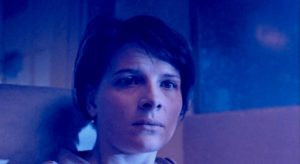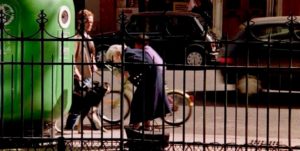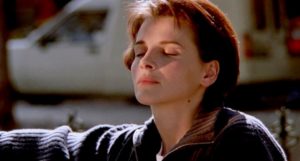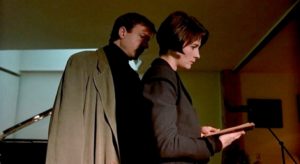Three Colors: Blue (1993). Written by Krzysztof Kieslowski and Krzysztof Piesiewicz. Directed by Krzysztof Kieslowski. Music by Zbigniew Preisner. Starring Juliette Binoche, Florence Pernel, and Charlotte Véry. 98 mins. Rating: R. Rotten Tomatoes: 98%; Metacritic: 85%.
Suddenly, she’s a widow and also childless. Just about all the bad that can happen to someone falls upon her in a stroke, or rather, a bad brake line. And that is just a few minutes into master filmmaker Krzysztof Kieslowski’s masterpiece, one of the most remarkable films ever made, Three Colors: Blue (1993). The rest of the film tracks Julie Vignon de Courcy (a luminous Juliette Binoche) as she copes with the grotesque reality of it all. Her eight-year old daughter died, along with her husband, and she is suddenly alone save for an ancient mother who no longer recognizes her. For the most part, Julie wouldn’t mind joining her in oblivion (she can’t bring herself to kill herself, though she tries), so much so that she copes by not coping, namely by working hard to erase the past by ridding herself of all material remembrance and personal memory–in short, by going mindless and numb. Good luck with that, Julie being Julie.
After her own convalescence from her injuries in the accident, Julie empties the couple’s country house, and especially her daughter’s bedroom, save for one memento, a blue glass mobile that hung from the ceiling light in the blue room (as becomes clear, blue is Julie’s favorite color). Additionally, she tries to sheer off all human relationships, moving to the anonymity of Paris, taking a corner apartment in a building that does not permit children. And there she would remain, allowing herself only the barest pleasures of physical existence: an afternoon coffee, a cigarette, or the pleasant warmth of the sun. Focus on the small pleasures of the external world keeps her mind off her inestimable losses.
And there she would remain, save for the music, music that will not let her alone, and she goes to extremes to eradicate every shred of it (the music by Zbigniew Preisner, Kieslowski’s usual composer, is quite remarkable and still available, even in a new vinyl record edition). The culprit in this case is a fragment from an unfinished symphony by her late husband, a much-celebrated classical composer. And when from seemingly nowhere the music appears, like an angry lion, it envelops Julie, swallowing her whole, mind and soul, and she has no power to dismiss or confute it. As T. S. Eliot memorably put it, “You are the music while the music lasts,” and such befalls Julie.* And psycho-emotional waves of blue haze seem to envelop her as the music plays, as is shown dramatically in its first visitation while Julie convalesces.

So much so she rages against the music and its mysterious compulsive power over her, even tracking down what she thinks are the sole extant manuscript copies to commit them to oblivion, even as, ironically, the very same roars in her head.

What we have, then, strangely enough, is a musical mystery tale, the “answer” to which profoundly affects the fate of Julie and others. That is: what is it about the music that exerts such power?
Indeed, something in the music will not desert her desolate soul, hauling her back into the very fullness of the experience she has sought to reduce to minimalist insularity. In short, a woman who at one time was notably kind, generous, and genuinely “good” now strives to blot out the world and any connection to it. In one telling scene, Julie sits with her eyes closed on a bench basking in the sun oblivious to the arduous labor of severely bent-over old woman as she struggles to insert a bottle into a large recycling container.


The wordless sequence presents a striking indication of the extent of Julie’s withdrawal (indeed, Three Colors: Blue is in spoken text virtually a silent film). Still, neither music nor life itself will let her retreat. And when they do come calling, Julie responds, however reluctantly. Indeed, Julie, being who she is in bones and soul, feels compelled to respond, no matter how much she’d like not to entangle herself again in this fraught thing called life.
First off, she reluctantly helps an intrusive apartment house neighbor Lucille (Charlotte Véry) whom other neighbors would like to kick out of the building because of her “nocturnal lifestyle,” so to speak, part of which involves performing in a sex club. In terrible distress one evening, the neighbor calls Julie, and Julie goes to her aid at the club, though that leads to Julie’s inadvertent recognition that her late husband had a mistress. An even bigger “call” comes from Olivier (Benoît Régent), her husband’s long-term assistant and protégé, who seeks her help in finishing her late husband’s incomplete last symphony, a commissioned work to celebrate the unification of Europe into the Eurozone.
And it is there that Julie “re-enters” music, and life, the first initiating the second. Slowly, reluctantly, music brings her to once again take up “living,” something she has nearly forgotten how to do. And what the music is about and “sings” also makes a difference. In his efforts to complete the unfinished symphony, Olivier struggles with understanding composer Patrice’s notes for the choral final movement, the text for which comes in Greek, literally, a language he does not know, though Julie knows the source and the translation. She shares the passage with Olivier so he might find the intended rhythm that will carry the words.

As he hums a possible scoring, Olivier voices aloud occasional words from the text: “of angels” and “love.” Those who know Paul’s most famous passage, rhapsodic in its own right, recognize the source, though in France and the United States, at least now, few would (not all editions of the film have those words subtitled; the recent Criterion edition does). No matter, though, for the remarkable close of the film he slowly sings phrase by phrase the whole of the text over a long montage of the different people in Julie’s life, including, first and last, Julie herself. Strangely, perhaps miraculously, with word, music, and images, we come to see, as does Julie, divine holy love as the wellspring, the first and the last, of all of life, no matter the assaults and woe that befall every living creature.** And lastly, it is not a stretch to say that in the music, orchestral and textual, resides the voice of God, or at the very least God speaking by whatever and all means possible. And that to the whole self, including body and spirit, surpassing though not discarding the rational-propositional intellection. Here Kieslowski provides a path to a more expansive and deeper non-rational re-cognition about how God displays God’s presence. Sounds and images, after all, can perhaps tell deeply, saliently, and perhaps even more fully than words, however desperately we need and love them as we do (and should).
*The lines come from “Dry Salvages” in Eliot’s Four Quartets (), perhaps the greatest of twentieth century poems.
or music heard so deeply/
That it is not heard at all, but you are the music/
While the music lasts…
**A full treatment of this stunning film, “The Sound of the Color of Love: The Construction of Meaning in Kieslowski’s Three Colors: Blue,“ is found in Anker’s Catching Light: Looking for God in the Movies (Eerdmans, 2004): 364-401.
Article written by Roy Anker.
Sign Up for Our Newsletter!
Insights on preaching and sermon ideas, straight to your inbox. Delivered Weekly!
Categorized into Love, Suffering
Three Colors: Blue (1993)